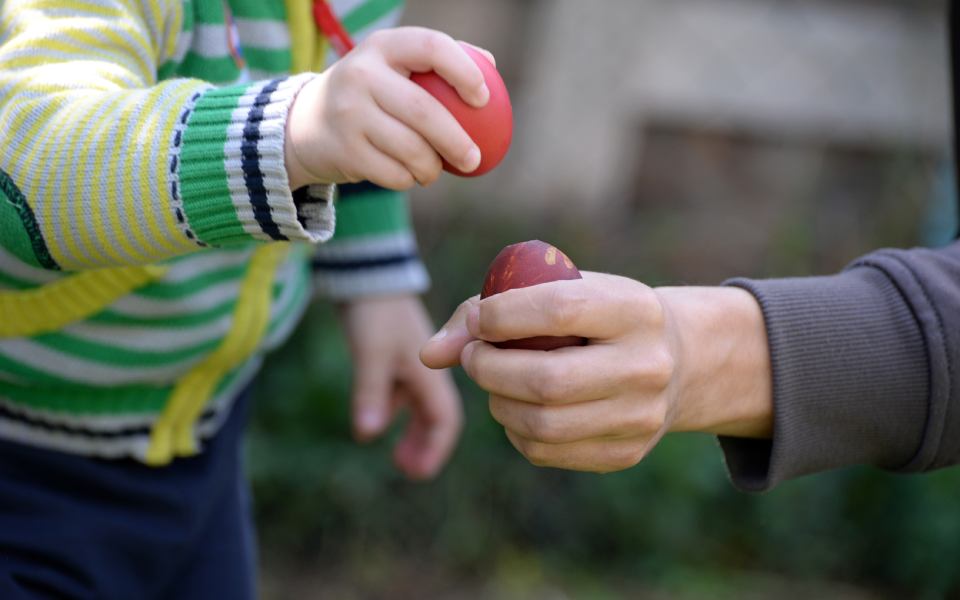
Life
How to Win at Greek Egg Tapping
Red eggs at the ready: your guide to making sure you win the Easter game.
It’s that most wonderful time of the year. No, I’m not talking about Christmas, I’m talking about Easter, specifically Greek Easter, an event so big it even overshadows the birth of Jesus. Why celebrate your birthday when you can celebrate your re-birth day, right?
The traditions for celebrating Easter vary across the country, but wherever you go in Greece, you’ll find one common factor ‒ the red eggs. These are boiled, colored and then arranged on display on the Thursday before Easter, and when the clock strikes midnight into Easter Sunday, the celebration begins. The eggs are produced and the tsougrisma, or tapping, ensues where everyone taps the narrow end and the wide ends of the shell, seeing which ones crack. The person doing the tapping says Christos anesti! (Christ has risen) and the one whose egg is being tapped replies Alithos anesti (Indeed he has) until there are just two people left. The last one standing is declared winner.
Egg tapping, also known as jarping, shackling or dumping is not a unique tradition to Greece. It’s also found in India, Croatia, Romania and in Jewish culture. In fact, in the UK and especially in America, egg jarping is a serious competitive sport with strict rules, secret calcium-rich diets for competitors’ hens and tricks such as boiling the eggs pointy end down to ensure the air pocket at the bottom doesn’t shift and weaken the strength of the shell. There is an annual championship and even a World Egg Jarping Association.
The reason behind the Greek tsougrisma is lost to the sands of time, though the common belief is that eggs are a perfect representation of spring and the beginning of new life, symbolizing the rebirth of Christ. There are two main theories for their being red. The slightly morbid one says that the red color represents the spilt blood of Christ during his crucifixion. The other, jollier interpretation says that red is the color of happiness.
The game is largely down to chance, but if you’re one of those people who must win at all costs, there are a few things you can do to sway your chances of success.
1. Start with the right eggs
As the saying goes, prior preparation prevents poor performance, so it all starts with the raw ingredients. Go to the egg vendor at your market and ask their advice. If you don’t have a market or a vendor, get the best eggs that money can buy. Pro tip: an ostrich egg doesn’t count, this is a game of democracy, not a dictatorship.
As for what role shell color plays in shell strength, none. White shells are no better than brown ones, and vice versa. So don’t be racist. What does play a role though is whether the hens were farm-reared or commercial. Free range or farm eggs have harder shells because of the better diet that the chickens have. So shell out (ha!) a little extra cash for the better ones.
2. The boiling process
Let the eggs come to room temperature if you had them in the refrigerator. Inspect carefully for any cracks. If you’re not planning on using chemical dyes, you’ll need to boil them along with the plant dye ‒ see the next step before proceeding.
Fill the pot and carefully add the eggs to the cold water, one by one. Don’t cram too many in there, the idea is for them to boil gently without cracking by knocking into each other. Some people swear by putting a dishcloth in the bottom of the pan. Competitive types boil theirs in cardboard boxes inside a pan. Place over a gentle heat. As soon as the water begins to boil, turn the heat right down and allow to boil for 20 minutes. Turn off the heat and remove the eggs to dry.
3. The dyeing process
If you’re not a hippie you probably won’t be bothered either way about what type of dye to use. Commercial dye is sold in all Greek supermarkets before Easter, so grab a packet and follow the instructions. You can also get colors other than red.
If you want to do it au naturel, then go back a step. Wipe your eggs with a cloth dipped in vinegar to ensure a good color, and add them to the pot. Before you turn the heat on, add a cup of vinegar to the water and the dry outer peels from 10 large red onions. Once the water starts to boil, turn the heat right down and leave to boil for 20 minutes. Turn the heat off and let them rest for a further 15 minutes to make sure the eggs get a nice, strong color. Leave them overnight if you really want a good finish.
4. To polish or not to polish?
Once the eggs are dyed, any self-respecting person will tell you that the next step is to polish them. The commercial packets of dye come with a special little packet of oil for this purpose. If you can’t be bothered to do this, delegate the task to your nearest granny or small child. I’m pretty sure this entire process was designed for people with time on their hands, like grannies and small children.
5. Go hard or go home
Now for the fun part. If you are hell-bent on winning, here are some of the best tricks to harden your shell and seal your victory. A word of advice, after these treatments you will have a lethal weapon on your hands that should not be consumed.
Clear nail varnish:
Once the shell is fully dry, paint the shell liberally with clear nail varnish. Let it dry before using.
Decoupage glue:
The next level up is decoupage glue which is glossy and used to harden paper decorations. Apply in thin coats and allow to dry in between layers.
Liquid sodium silicate:
Sodium silicate, or ‘water glass’ actually was used back in the day to preserve fresh eggs in barrels of water. They could be stored for months in this way. A bit of research online shows that science nerds swear by dipping the egg in liquid sodium silicate and drying it for a rock-hard finish.
6. Picking the right egg
It’s Easter Sunday. The basket or plate of eggs has started to do the rounds. You’ve decided not to go all Breaking Bad on the game and are doing it the honest way, but you can still stay ahead with the correct strategy.
Position yourself so that you are one of the first people to get to choose an egg, otherwise you’ll be left with only the second-rate leftovers. Better yet, offer to fetch the eggs to distribute, and quietly make your choice before anyone else. Larger is not necessarily better. Look for one that’s not damaged or cracked and which has a pointy narrow end. Scientists have found that the pointier the egg, the stronger it is.
You can also test the shell by tapping it against your teeth. A good shell will make a light, high-pitched tap, while a weaker one will make a duller sound.
7. Battle positions
The rule is that you start with the same ends: pointy to pointy, wide to wide, until you go down to whichever end is still undamaged. Use a firm hand and a steady grip.
8. If all else fails, cheat
Every Greek family has one member who almost always wins this game, to accusations of their egg being made of wood. Get yourself a wooden one from a toy outlet and use that. No one will know unless you let them inspect it later.







